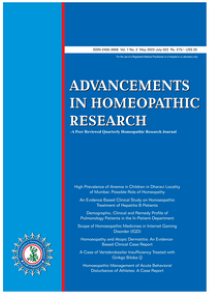Effectiveness of Homoeopathic Treatment in Haemorrhoids- An Observational Study
DOI:
https://doi.org/10.48165/ahr.2022.7.3.7Keywords:
Disease intensity score, Homoeopathy, Haemorrhoids, Homoeopathic medicinesAbstract
Background & objectives
Haemorrhoids are certainly one of the commonest ailments that afflict mankind. Bleeding and prolapse are the cardinal symptoms of haemorrhoids. Pain, mucus discharge and Itching, are the other most common complaints from the patients. This leads to reduced work efficiency, quality of life and increased financial burden on the patients. Homoeopathy is reported to have a significant role in haemorrhoids in both classical literature and recent studies. However, its efficacy in the South Indian population has not yet been reported. Thus, an effort has been made to find out the effectiveness of Homoeopathic treatment in haemorrhoids.
Methods
In this prospective, observational study, conducted at Fr. Muller's Homoeopathic Medical College and Hospital, Mangalore during the year 2002-2003, on patients of age groups between 20-75 years, based on their clinical presentation such as bleeding, pain, discharge, itching and examination. They were treated with homoeopathic medicines, using disease intensity scores as a parameter. This study protocol was approved by the Institutional ethical committee of Fr. Muller's Homoeopathic Medical College and Hospital, Mangalore and consent was obtained from the participants. All the patients were followed for a minimum period of 3 months.
Results and Discussion
A total of 30 patients were enrolled and analyzed for the study. After treatment significant change is found in bleeding, pain, pruritus ani, and mucus discharge per rectum of the patients. However, no change is found in Prolapse. Symptoms were graded ranging from 0-3 depending upon the severity of the complaint. The sum of these grades were considered before and after treatment for the patients. Most frequently used medicines were Sulphur (n = 6), Lycopodium (n = 5), Natrum mur (n = 4), Pulsatilla (n = 3) and Nux vomica (n = 3). The Statistical analysis ‘t-test’ showed, that the calculated value of 13.7 is greater than the tabled value of ‘t’ at the 5% level with 29 df (2.045). This shows the positive effect of homoeopathic medicines in the treatment of haemorrhoids.
Conclusion
It is concluded that homoeopathic treatment is effective in haemorrhoids, which is reflected in significant reduction in symptoms of haemorrhoids, as observed with the disease intensity score.




